Fly-drive Argentina
From the subtropics to the most southern city in the world
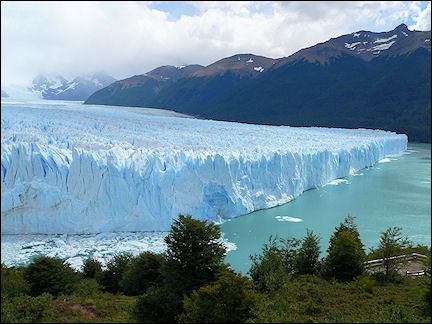
|
From the lake district near Bariloche on Ruta 40 by way of the dry foothills of the Andes Mountains southward to the glaciers in National Park Los Glaciares near El Calafate. By airplane to Ushuaia for a boat trip on the Beagle Channel amidst seals en penguins. Crossing Patagonia - which turns out to be prettier on the Chilean side - northward on Ruta 3. On Peninsula Valdez are penguins and seals. Via Buenos Aires to Mendoza and the Andes Mountains.
Travelogue:
Ankie Kaskens
Photos:
Peter Kaskens
We enter Argentina in a rental car, coming from Chile. There are problems at the customs office about importing the car. A clerk takes a look at all our papers, consults with a colleague, and eventually refers us to the next window. The military staff at the next window doesn't know what to do either.
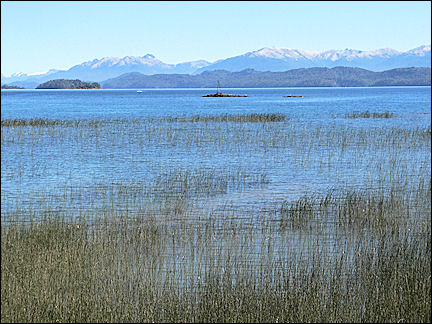
|
The whole procedure delays us, so we only arrive at 7 PM in San Carlos de Bariloche. Without too much trouble we find a room with a view of Lake Nahuel Huapi.
We take excursions in the surroundings. The Chilean lake district we passed on our way to the border connects via the Andes to the lake district in Argentina. Remarkable are the views of many volcanoes.
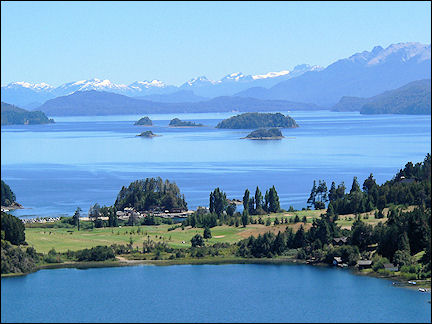
|
It's vacation season here and on top of that there are many backpackers in Bariloche. The population in this area identifies with the Swiss. There are people walking St. Bernard dogs in the streets, with which you can have your picture taken - for a fee, of course. And the place is swamped with chocolate stores. So many, actually, that the shopping street smells of chocolate.
In winter this is a popular area for skiing. We drive up to the ski pistes at Cerro Cathedral, where the view is great. Now, during summer, it's all green and the lakes look wonderful.
Ruta 40
The dry foothills of the Andes Mountains
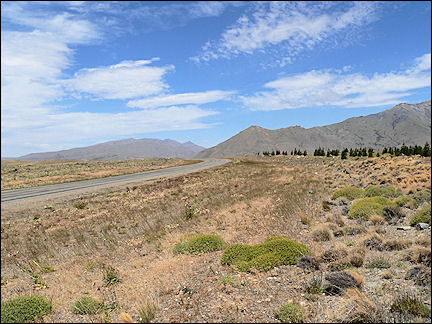
|
We take Ruta 40 south through the dry foothills of the Andes Mountains. We stop in El Bolson. In the last century this was a hippie commune, but there is little remaining of that. It's a lively vacation resort for Argentinians.
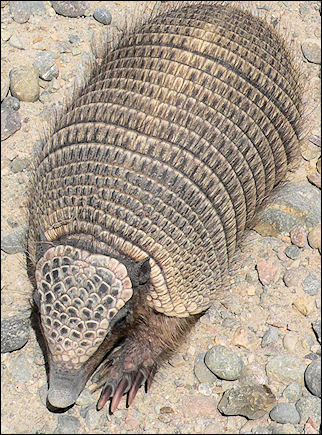
|
We spend the night in a cabana just south of Tecka. There is a strong, cold wind coming from the plains, and doors and windows are rattling. We try to find stuff in the local supermarket to prepare dinner with, but there isn't a lot to choose from.
Until we reach Rio Mayo, we are driving on an asphalted road, but beyond this place it's road metal all the way to Perito Moreno. A large part of the bank for an asphalted road is ready: we have to cross it regularly. Some people think that the atmosphere and charm of Ruta Quarenta (40) are lost by asphalting; we decide we won't come back here until the whole route is asphalted. The current road slows us down and driving on it is very unpleasant. Our large family car is also not suited for this.
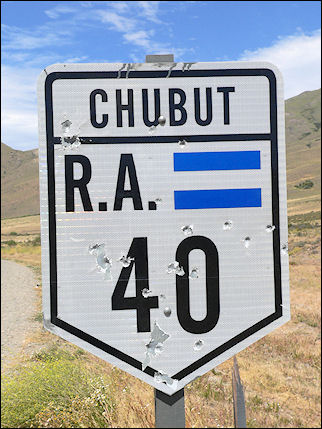
|
Near Perito Moreno we are stopped by the police, who check our papers and ask where we're going. This will happen quite often in Argentina, but our papers are always found in order.
From Perito Moreno we have another 60 kilometers of asphalted road before we will be on road metal. When we get there, the road is even worse than before, but the views make up for a lot. We see all kinds of animals: guanacos, nandus and a super-sweet armadillo.
In this area Butch Cassidy and the Sundance Kid had a ranch for a couple of years. That it's still wild country is indicated by the bullet holes in the traffic signs.
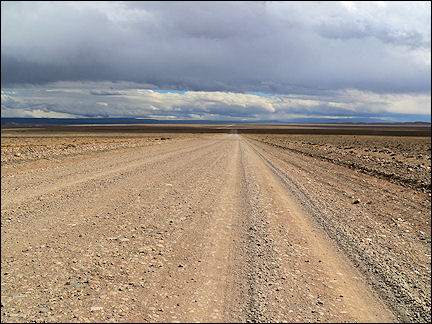
|
When we arrive in Baja Caracoles around 6 PM, we have a flat tire. I book a room in a hotel/village store. Peter takes the punctured tire to a garage, where he is third in line.
Repairs and sales of car tires are good business along this road. From a conversation with two motorcycling Aussies, we learn that the worst part is yet to come.
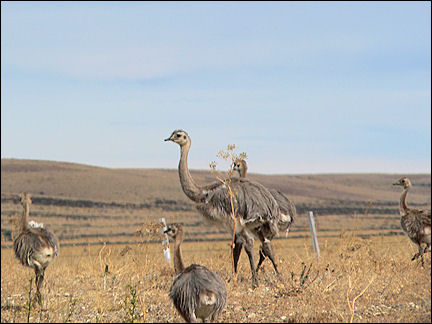
|
Another 350 kilometers on this road metal, no towns along the route and only one spare tire. It makes me very nervous that night. So next morning we decide to go back and take a 1,400 kilometers detour on asphalted roads to El Calafate.
We return to Perito Moreno, pass the police checkpoint again and then cross the country toward the Atlantic Ocean. We drive through huge oil fields with nodding donkeys. They don't make the landscape any prettier. It also gets flatter. And it rains every now and then. But the upside is that there is hardly any traffic on these two-lane roads, so we can keep driving a maximum speed.
El Calafate
Getting very close to a wall of glacier ice
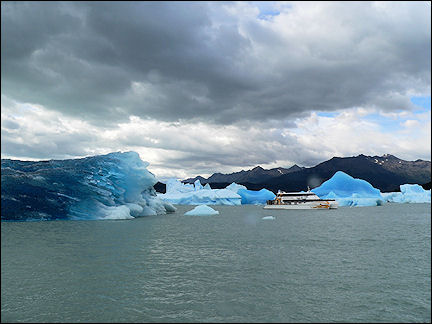
|
After a stop in St Julian on the coast we drive west again, by way of Rio Gallegos to El Calafate. El Calafate is a tourist resort that owes its existence to the glaciers in the surroundings. We find a hotel room and the next day we drive to National Park Los Glaciares, with its famous Perito Moreno glacier.
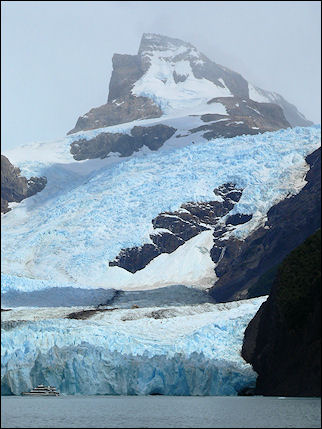
|
We take a boat that goes very close to the wall of ice. The glaciers in this area all end in clear-blue, cold lakes. After the boat trip we walk up wooden stairs to a viewing point. With every every bang we hear (and they sound like cannon shots) a piece of ice breaks off of the glacier and falls in the ice-cold water. It is a spectacular view. And as a bonus a large condor floats over our heads.
The next day we take an all-day boat trip. We visit the Upsala glacier and sail on Lago Argentino. Near the glacier large pieces of ice float on the water. Some chunks are bright blue because they still have a lot of oxygen in them. The color disappears after a few hours.
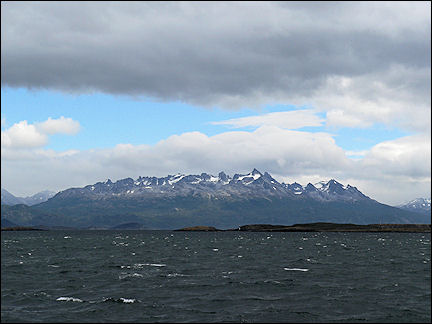
|
The boat takes us to the other side of the Perito Moreno glacier. There are many vacationing Argentinians on board, some are constantly drinking maté (a kind of herbal tea) from a pot with a silver straw. You see those pots everywhere in souvenir shops. At the end of the day we have seen enough ice for a while.
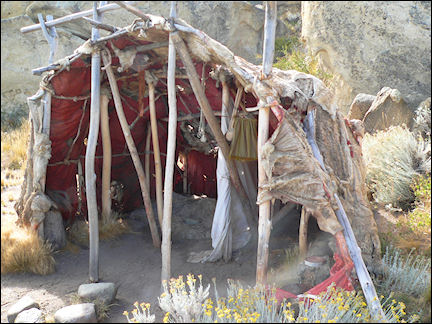
|
Just outside El Calafate is an old Tehuelche settlement. They were the original population, who lived here already 4,000 - 8,000 years ago. Their dwellings have been reconstructed: they were made of wood and animal skins. There are also caves with some vaguely visible cave paintings.
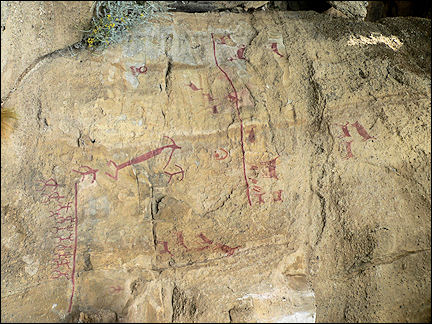
|
They are somewhat similar to the Aboriginal cave paintings we saw in Australia. Punta Walichu, as this place is called, is privately financed; the Argentinian government is hardly interested in the history and culture of the original population.
Ushuaia
Seeing penguins and seals in the Beagle Channel
We fly to Ushuaia for a three days visit. The main reason to take a plane are the many kilometers we doubtlessly will have to drive on unpaved roads in Tierra del Fuego. We also will have to take the car through customs twice. The hotel manager in El Calafate keeps our car and most of our luggage while we take this trip.
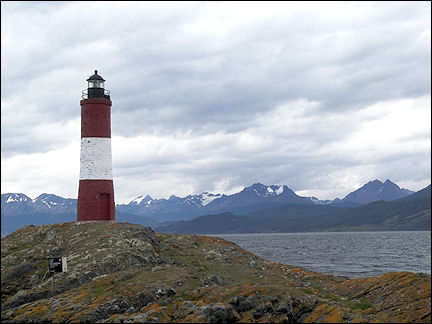
|
It's busy in Ushuaia, the most southern city in the world, because a large American cruiseship has docked. Souvenir shopes and restaurants are filled with customers, in a town that calls itself "The End of the World". It's summer, but not very warm (12-13 degrees centigrade) and there are occasional showers.
Some smaller ships are also docked in the port. They offer cruises to Antarctica. There are still open spots, but it's too cold and too expensive for us.
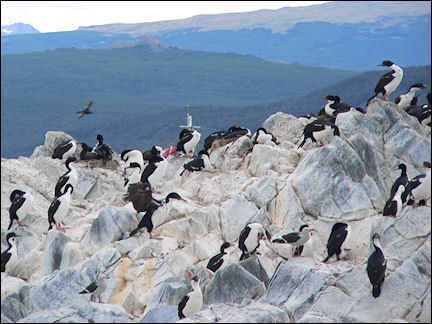
|
We take a trip on the Beagle Channel. On the way we see many seals on Isla de los Lobos, also birds and a penguin colony. We pass a lighthouse that is supposed to be the most southern one in the world.
It's chilly on deck, we have to bundle up. It's usually cloudy in this area. On the banks of the Beagle Channel are farms, estancias, that can be visited. The climate can't have been the attraction for the colonists: judging from the trees there always is a strong wind from one direction.
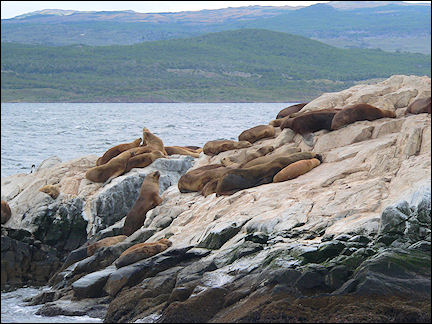
|
We are impressed by the old prison of Ushuaia. Until 1896 Ushuaia was a small settlement, but in that year the first prisoners were transferred here. They built houses and also the prison. They actually were colonists.
In its heyday there were 600 prisoners in Ushuaia. The prison has endless corridors with cells. You get a good impression of life as it was lived here. Prisoners who behaved well had a chance for education and a paid job. The prison was closed in 1947.
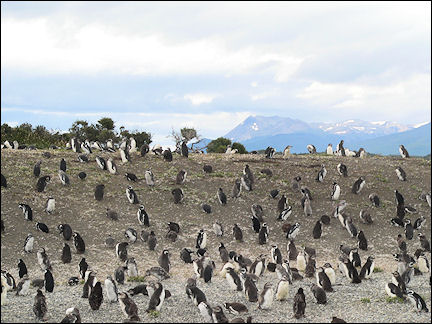
|
We meet a Dutch park ranger. He has hiked on his own in the woods of Tierra del Fuego for six weeks, carrying 40 kilos of luggage (a tent and food for the whole period). Every now and then he caught a fish for lunch or dinner. You really have to get along with yourself to be able to do this.
The park ranger finds our way of traveling - get in a car and see where you end up - also appealing.
Patagonia
When the sun shines, bring your own shadow
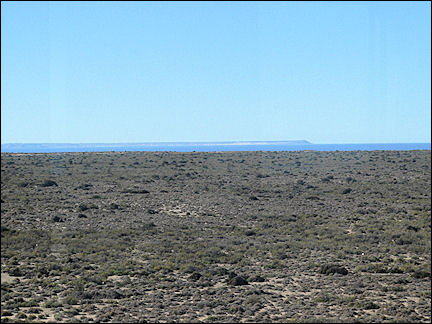
|
We fly back to El Calafate and continue on our route. We drive south and cross the border into Chile at Dorotea. After we have visited Torre del Paine and Punta Arenas, we return to Argentina.
For three days we hurry north through an extremely boring landscape, even less interesting than we imagined. Patagonia turns out to be only attractive on the Chilean side of the Andes Mountains. The east side has only small shrubs in the colors green, dark-green and dark-brown, livened up now and then by crossing guanacos. When the sun shines, bring your own shadow, because there are no trees at all.
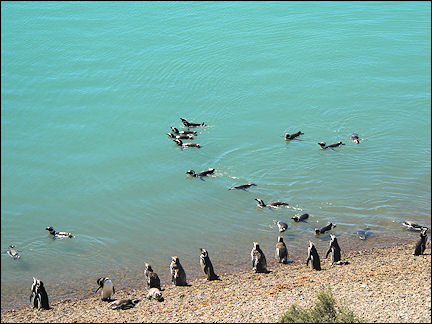
|
We spend the first night in Port St. Julian. Ferdinand Magellan lived here for a few months in 1520, before he discovered the strait that was named after him. Because the sea is rich in fish, this is a popular vacation destination. There also is a penguin colony nearby.
The second night we stay in Commodore Rivadavia, an oil-industry town. The cheaper hotels tell us that parking in the street is unsafe, so we are forced to take an expensive hotel. It's Saturday night and maybe because of that, it's noisy in the hotel all night long.
Peninsula Valdez
Seal cubs go to the nursery
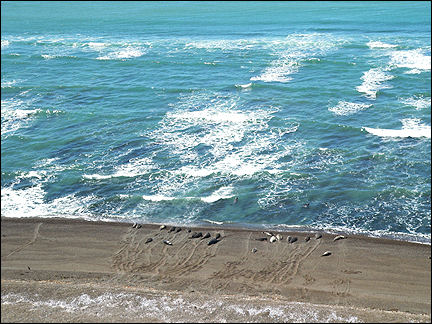
|
After the third day we arrive in Puerto Madryn, a tourist resort on the coast. We book a trip to Peninsula Valdez, a nature reserve.
The landscape there is exactly like that on the main land, but it is famous for its wildlife. We see a large penguin colony on the beach, with one lost emperor penguin.
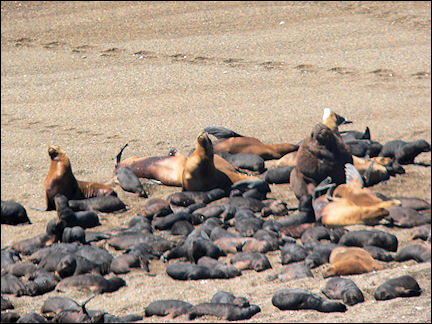
|
There also are a sea elephant and a seal colony. It's noisy there, because of the mating season. We see a fight between a couple of those behemoths.
Seal parents who go foraging bring their cubs to a nursery. There they are guarded by some mothers, because the large males are a danger to the cubs.
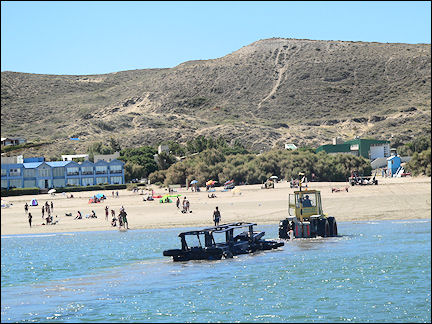
|
Puerto Pyramides is a beach resort on Peninsula Valdez, where we board a ship for an excursion that takes us along the rocks, where we see many sea birds and seals. It's not the season for whale spotting, they are farther south now.
Puerto Madryn is a beach resort. The beach is crowded. The town was founded in 1865 by immigrants from Wales, United Kingdom.
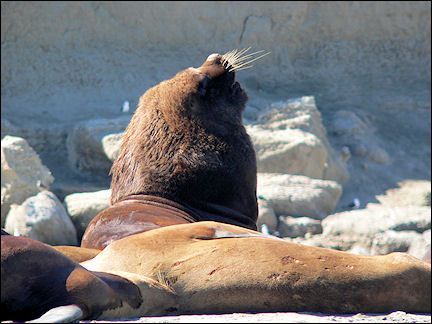
|
We frequently pass some kind of chapels or memorials along Ruta 3 that look like dark-red doghouses. They are decorated with red flags and furnished with all kinds of objects. I ask our guide what they are.
Antonio Gil, aka El Gauchito, was a 19th century Argentinian Robin Hood. He deserted from the army, was arrested several times and eventually sentenced to death. He was killed with a cut in his neck. Before his execution he said that his blood was innocent and that through him there would always be a line to heaven.
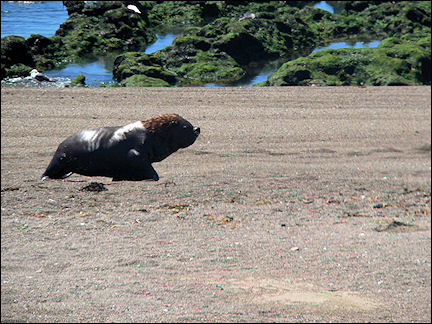
|
"Proof" of this was that he said that a child of one of his executioners was gravely ill and would only recover if he would be buried. Executed felons were never buried. The child turned out to be sick indeed and after Gil was buried, it got better.
Gil was adopted as a patron saint by long-distance truck drivers. They built memorials for him at many places along the roads. Drivers always honk when they pass one. Judging from the number of chapels, Gil must be very popular.
Buenos Aires
Corrugated iron sheets painted in bright colors
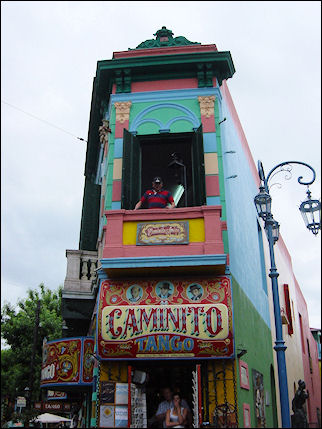
|
We still have to drive north for a few days on Ruta 3, via Bahia Blanca and Azul, before we arrive in Buenos Aires. We book a hotel in Buenos Aires in advance on the internet, so we don't have to worry about parking space. To our great relief, the landscape has changed. We drive between pampas, large green pastures with black cows.
We arrive in Buenos Aires early in the afternoon. On the Avenida 9 de Julio we have to move from the far right lane seven lanes to the left. It's a matter of pushing, no one gives you an opening. With the map on my lap it's no problem to find our hotel in this city of millions.
It's the Savoy hotel, from where we can walk to most destinations in the city center. We begin immediately the next day.
We have coffee at Tortoni, the oldest café-restaurant in the city. When we look at the clock here, we find out we are an hour behind. Somewhere between Bahia Blanca and Buenos Aires we must have crossed into another time zone without noticing.
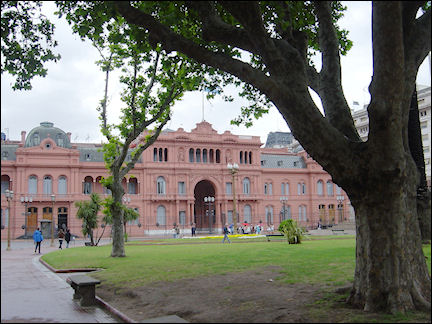
|
There's a line in front of Tortoni, but we don't have to wait very long. After our coffee we walk to the Plaza de Mayo, which is more quiet than we expected without the "Mothers of the Plaza de Mayo". There is a line of military police, because a ralley is on its way to the square. We take a cross street to the San Telmo district.
San Telmo has lots of antique stores and markets and of course outdoor cafés. The taxi driver who takes us to La Boca afterwards speaks English fairly well. He is a great source of information. He is very critical about the current situation in Argentina. On the way he points out the soccer station of Boca Juniors.
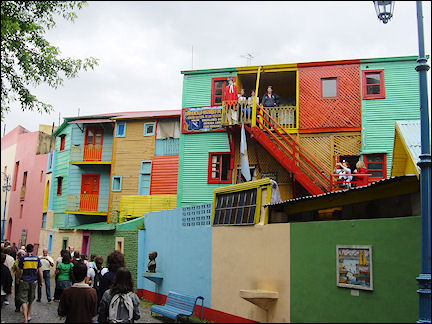
|
La Boca is an old immigrants district, with corrugated iron dwellings. In one part they are beautified and painted in bright colors. Cafés have built platforms on which couples dance the tango and tempt visitors to join them. And there is also dancing in the streets.
La Boca is a real artists district and many painters offer their work for sale. We spend hours in an outdoor café.
The Puerto Madero district has a bridge designed by the famous contemporary Spanisch architect Calatrava. Along the water, old warehouses have been renovated and converted into trendy apartments, as in many cities in Europe. For tonight, we have tickets to "36 billiaros" on the Avenida de Mayo, for a dinner with song and tango performances. We have seen the couple who perform before: yesterday, in La Boca. The tango world is small, apparently.
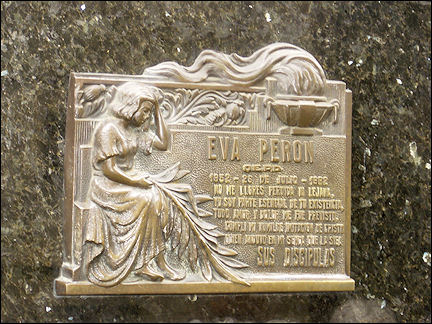
|
Evita Peron's tomb is in La Recoleta cemetery. The walled-in cemetary is a town by itself, with a main street and cross streets. At the entrance is a sign with directions to graves of important people. Evita's grave, in a narrow cross street, draws many visitors. People bring fresh flowers every day.
It's Sunday and crowded in the cemetary. Everywhere else, people are walking their dogs. During the week this is done by dog-walking services. Dogs here have owners, which is not the case everywhere. An Argentinian told us: dogs are a problem and they belong to no one, just to the streets. But nobody does anything about it, so we keep feeding them.
Mendoza
The snowy peaks of the Andes Mountains can be seen from afar
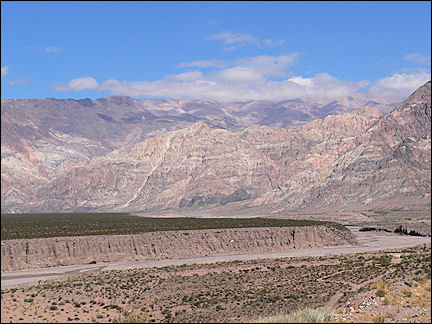
|
From Buenos Aires we drive west to Mendoza. We spend the night in Rufino. This part of Argentina currently experiences a heat wave. In Rufino it's 50 degrees centigrade. Only late in the evening people go out. There is nothing interesting about this town.
San Luis, the next town, looks better. The farther west we get, the dryer and browner the landscape.
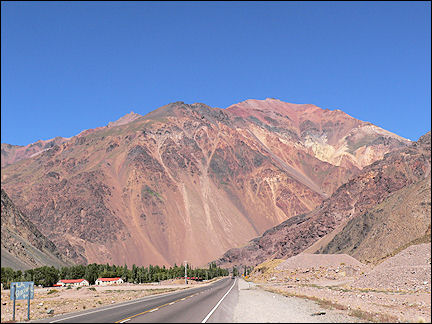
|
Mendoza's city center had large and small parks with beautiful, tall trees. They are watered by a sophisticated irrigation system that gets its water from the Mendoza river, which of course originates in the Andes Mountains.
The snowy peaks of the Andes Mountains can be seen from afar: the highest peaks are in this region. In the foothills are vineyards and we have a foretaste on one of the many outdoor café in the shade of trees.
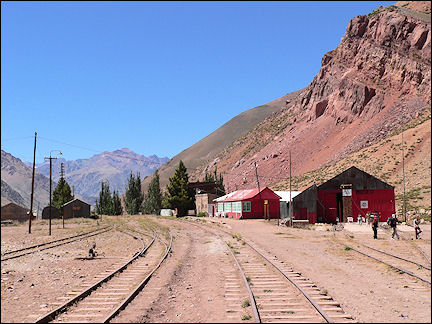
|
Mendoza's largest park is Park General San Martin. It's so huge that our cab driver offers to drive us around. He knows his way here and shows us many sights. People are playing sports in the many sports facilities, including a rowing course.
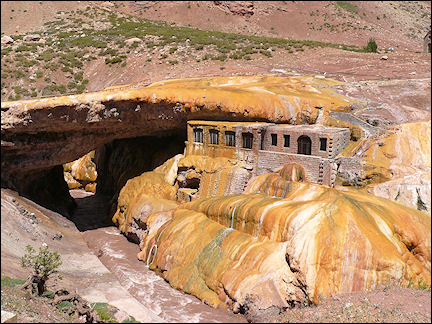
|
We take a wine tour in the afternoon; we visit two bodegas and an olive oil plant. Before the tour, we visit a church dedicated to the patron saint of winegrowers, Virgen de la Carrodilla. We don't drive ourselves, so we can drink as much wine as we want..
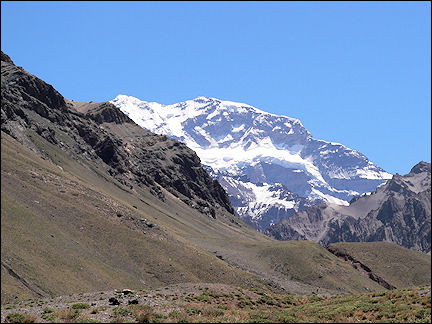
|
The next day we drive through the Mendoza Valley and then turn west to the Chilean border. A well-known observation spot is Puente del Inca, a natural stone bridge with brown and orange colors, caused by vapors that rise from mineral sources.
The views are great. Some kilometers ahead we will cross the border and leave Argentina.